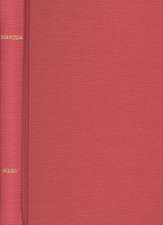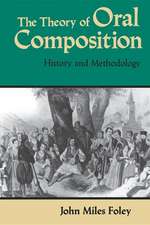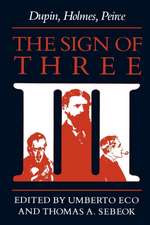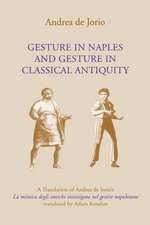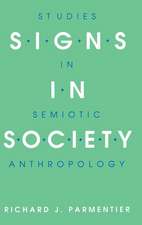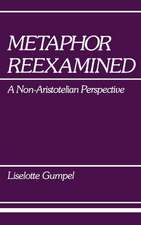A Semiotic Theory of Language
Autor Sebastian Shaumyanen Limba Engleză Hardback – 21 mai 1987
Preț: 287.34 lei
Nou
Puncte Express: 431
Preț estimativ în valută:
54.99€ • 57.08$ • 45.85£
54.99€ • 57.08$ • 45.85£
Carte tipărită la comandă
Livrare economică 22 martie-05 aprilie
Preluare comenzi: 021 569.72.76
Specificații
ISBN-13: 9780253304728
ISBN-10: 0253304725
Pagini: 372
Dimensiuni: 152 x 229 x 15 mm
Greutate: 0.69 kg
Editura: MH – Indiana University Press
ISBN-10: 0253304725
Pagini: 372
Dimensiuni: 152 x 229 x 15 mm
Greutate: 0.69 kg
Editura: MH – Indiana University Press
Notă biografică
Sebastian Shaumyan
Cuprins
I. The Aim and Structure of the Semiotic Theory of Language
1. A Semiotic Definition of Language
2. The Principle of Semiotic Relevance and Homonymy
3. Saussure's Notion of the Sign
4. Linguistics as a Part of Semiotics
5. The Goals of Linguistic Theory and the Semiotic Basis of Abstraction
6. Synchronic Linguistics and Diachronic Linguistics
7. Language Variation
8. The Semiotic versus Generativist Notion of Language
II. Phonology
1. The Phoeneme and Distinctive Features
2. Physical and Functional Segmentation of the Speech Flow
3. Further Problems of Functional Identity
4. Distinctive Features and Experimental Phonetics
5. Phonological Antinomies
6. Some Misconceptions about the Phonological Antinomies
7. Remarks on Bohr's Complementarity Principle and Dialectics
8. An Illustration: How the Functional View of Speech Sounds Gave Birth to One of the Greatest Discoveries in the History of Linguistics
9. Alternative Theories of the Phoneme and the Distinctive Features
10. Phonological Syntagmatics
11. On Generative Phonology
III. Genotype Grammar
1. Two Levels of Grammar: Genotype Grammar and Phenotype Grammar
2. The Basic Notions of Genotype Grammar
3. Constituency
4. Dependency
5. Constituency and Dependency as Complementary Notions
6. The Structure of the Sentence
7. Valence and Voice
8. The Typology of Sentence Constructions
9. The Paradox of Ergativity and Functional Superposition
10. Some Implications of the Integrated Theory of Ergativity for Linguistic Typology
11. An Informal Theory of Passivization
12. Alternative Theories of Passivization
13. The Formalism of Applicative Grammar
13. The Formalism of Applicative Grammar
14. A Comparison of Applicative Grammar and Montague Grammar
15. A Comparison of Applicative Grammar and Generative-Transformational Grammar
16. A Comparison of Applicative Grammar and Relational Grammar
17. A Comparison of Applicative Grammar and the Lexical-Functional Grammar of Bresnan
18. The Place of Applicative Grammar among Other Semiotic Systems
IV. Phenotype Grammar
1. The Task of Phenotype Grammar
2. The Word
3. The Structure of the Word and Morphological Formatives
4. Agglutination and Fusion
5. Syntagmatic Formatives
6. Concord and Government
7. Linguistic Categories
8. The Category of Case
V. Linguistic Methodology
1. Empirical and Conceptual Problems in Linguistics
2. The Analytical-Deductive Method and Imaginary Experiments
3. The Special Role of Linguistic Anomalies
4. The Complementarity Principle and the Centaur Concepts
5. Static and Dynamic Meta-languages
6. The Role of Anologies in the Semiotic Theory of Language
7. The Use and Abuse of Mathematical Formalism
8. The Notion of Semiotic Reality
Notes
References
Subject Index
Language Index
Name Index
1. A Semiotic Definition of Language
2. The Principle of Semiotic Relevance and Homonymy
3. Saussure's Notion of the Sign
4. Linguistics as a Part of Semiotics
5. The Goals of Linguistic Theory and the Semiotic Basis of Abstraction
6. Synchronic Linguistics and Diachronic Linguistics
7. Language Variation
8. The Semiotic versus Generativist Notion of Language
II. Phonology
1. The Phoeneme and Distinctive Features
2. Physical and Functional Segmentation of the Speech Flow
3. Further Problems of Functional Identity
4. Distinctive Features and Experimental Phonetics
5. Phonological Antinomies
6. Some Misconceptions about the Phonological Antinomies
7. Remarks on Bohr's Complementarity Principle and Dialectics
8. An Illustration: How the Functional View of Speech Sounds Gave Birth to One of the Greatest Discoveries in the History of Linguistics
9. Alternative Theories of the Phoneme and the Distinctive Features
10. Phonological Syntagmatics
11. On Generative Phonology
III. Genotype Grammar
1. Two Levels of Grammar: Genotype Grammar and Phenotype Grammar
2. The Basic Notions of Genotype Grammar
3. Constituency
4. Dependency
5. Constituency and Dependency as Complementary Notions
6. The Structure of the Sentence
7. Valence and Voice
8. The Typology of Sentence Constructions
9. The Paradox of Ergativity and Functional Superposition
10. Some Implications of the Integrated Theory of Ergativity for Linguistic Typology
11. An Informal Theory of Passivization
12. Alternative Theories of Passivization
13. The Formalism of Applicative Grammar
13. The Formalism of Applicative Grammar
14. A Comparison of Applicative Grammar and Montague Grammar
15. A Comparison of Applicative Grammar and Generative-Transformational Grammar
16. A Comparison of Applicative Grammar and Relational Grammar
17. A Comparison of Applicative Grammar and the Lexical-Functional Grammar of Bresnan
18. The Place of Applicative Grammar among Other Semiotic Systems
IV. Phenotype Grammar
1. The Task of Phenotype Grammar
2. The Word
3. The Structure of the Word and Morphological Formatives
4. Agglutination and Fusion
5. Syntagmatic Formatives
6. Concord and Government
7. Linguistic Categories
8. The Category of Case
V. Linguistic Methodology
1. Empirical and Conceptual Problems in Linguistics
2. The Analytical-Deductive Method and Imaginary Experiments
3. The Special Role of Linguistic Anomalies
4. The Complementarity Principle and the Centaur Concepts
5. Static and Dynamic Meta-languages
6. The Role of Anologies in the Semiotic Theory of Language
7. The Use and Abuse of Mathematical Formalism
8. The Notion of Semiotic Reality
Notes
References
Subject Index
Language Index
Name Index

